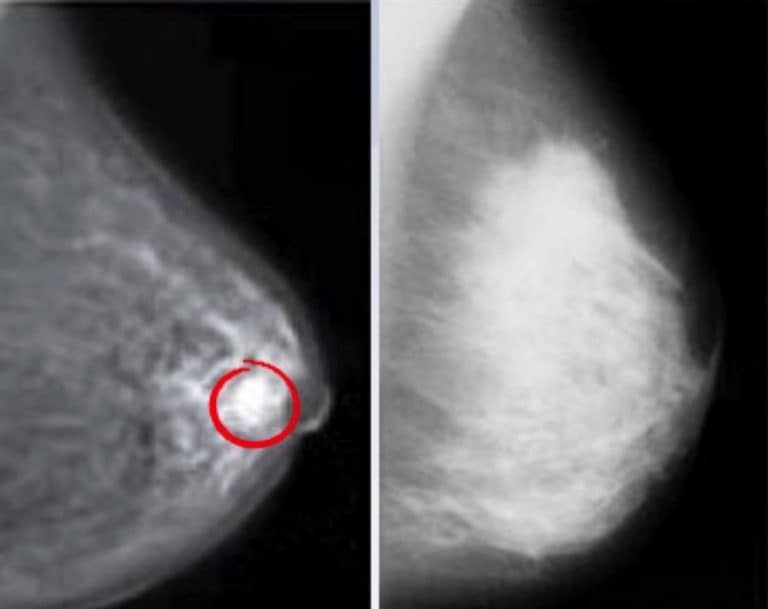Home » Patient Safety Blog » Breast Density Information
Many women aren’t aware that a mammogram is actually just a low-energy x-ray of the breast.
When the “mammogram” was put into use in the mid 1900’s, it was the best breast imaging tool available.
But studies performed in the 1990’s and early 2000’s have shown that mammography misses cancer in over half of the women who have “dense breast tissue”.
Unfortunately, many doctors still refuse to share this important information with their patients.

The excuses we’ve encountered for not disclosing the limitations of mammography have ranged from “I wasn’t aware” to “I don’t want to scare patients”.
The purpose of this article isn’t to engage in a philosophical debate over a patient’s right to know.
Instead, I’d like to focus on the fact that there are better options available (which don’t even include the use of ionizing radiation) for patients who have dense breasts.
These other testing options have long been available, and are far better than mammography at detecting cancer in women who have dense breasts.
Two of the most readily available testing options include breast-ultrasound and breast-MRI.
Countless studies have proven that ultrasounds and MRIs are superior to mammograms in detecting cancer in women who have dense breasts.
Cancerous tumors appear “white” on mammography images.
However, dense breast tissue also appears “white” on mammography.
Therefore, it can be impossible to see a white cancerous mass when it’s being obscured by dense, white breast tissue.
Because mammography cannot penetrate dense breast tissue, a large percentage of the breast image will appear “whited-out” which can obscure the detection of cancer.
This is why cancer is too often missed by mammography in women who have dense breasts.
Even more frustrating is the fact that doctors routinely report mammography examinations in women with dense breast to be “normal” and even go as far as saying there’s “no evidence of cancer”.
This isn’t a small problem as nearly half of the female population has “dense breast tissue”.
According to standard radiologic classifications, women who are deemed to have “extremely dense breasts” have breast tissue that is “above 75% dense”.
That means that cancer can be hiding behind the 75% — to 100% — of the breast tissue which is dense.

So what do radiologists mean when they say a mammogram is “normal” or “there’s no evidence of cancer” on the mammograms of patients who have dense breasts?
This may come as surprise, but they don’t mean “there’s no breast cancer”.
All that the radiologists are saying is that based on the areas of the breast that they can see – the areas not obscured by density – that there is no evidence of cancer in those areas.
So let’s take it a step further. In patients who have extremely dense breasts, that means the radiologists are only able to see the 25% or less of the actual breast tissue which isn’t dense.
In other words, what the radiologists should be saying is:
“The breast are extremely dense, but amongst the 0-25% of the tissue that is not dense, there’s no evidence of cancer there. However, there could be cancer that is being obscured in the other 75-100% of the tissue which is dense.”
If radiologists made sure to inform their patients of this, you would probably not be reading this article right now, and may have had a much earlier diagnosis of breast cancer.
Breast-ultrasounds and Breast-MRIs are widely available, and can identify the cancers that would be obscured on mammograms in women who have dense breast tissue.
The so-called supplemental tests are able to “see through” dense breast tissue, and can prevent a late-stage diagnosis of breast cancer in the population of women who have dense breasts.
If you, or someone you know, has dense breasts and wasn’t given the option to have supplemental cancer screening with breast-ultrasound or breast-MRI, call us for a confidential consultation at (800) 215-1003.
Here, at The DiPietro Law Firm, we’re committed to helping victims of sexual abuse and assault find the justice they deserve.
All information discussed during our consultations always remains completely 100% confidential.
Would you like our help?
Founder Anthony T. DiPietro, Esq. is a compassionate and skilled trial attorney who has completely dedicated the past 23 years of his career to litigating medical malpractice and sexual abuse cases against major corporate institutions including hospitals, medical clinics, schools, and other wrongdoers.
Mr. DiPietro has also obtained some of New York State’s highest verdicts and settlements, and has been selected to New York State Super Lawyers® each year, for the past 10 years in a row.
In 2022, Mr. DiPietro was selected as one of America’s Top 100 High-Stakes Litigators for the landmark cases he’s won on behalf of survivors of sexual exploitation and abuse.
Here, at The DiPietro Law Firm, we’re committed to helping victims of sexual abuse and assault find the justice they deserve.
All information discussed during our consultations always remains completely 100% confidential.
Would you like our help?
COLUMBIA UNIVERSITY PROTECTED Robert Hadden OB/GYN FOR 25 YEARS. FILE A CLAIM DEADLINE TO FILE IS FEBRUARY 28, 2025. FILE NOW! Exposed: The Cover-up at
There is no excerpt because this is a protected post.
Years of Abuse: 1987 – 2016
Brief:
Robert Hadden, a disgraced Obstetrician-Gynecologist (OB/GYN) who worked for Columbia University and NewYork-Presbyterian Hospital, was criminally convicted in 2016 of sexually exploiting and abusing patients under the guise of medical care.
Hadden used his position of authority and trust to sexually exploit women and girls for nearly three decades as a Columbia University physician.
All the while, Columbia University and New York-Presbyterian Hospital administrators turned their backs and ignored reports of Hadden’s abuse, gaslighting patients and the public.
Read More:
Years of Abuse: 1979 – 2022
Brief:
David H. Broadbent is a former OB/GYN under criminal investigation and facing civil lawsuits for sexual abuse of patients.
Broadent worked at multiple medical facilities in the Provo, Orem and Salt Lake City, UT areas.
These facilities included Intermountain Healthcare’s Utah Valley Hospital, MountainStar Healthcare’s Timpanogos Hospital, other Utah health care providers, and he also had adverse action taken against his medical license back in 1990.
Read More:
Years of Abuse: 1990 – 2016
Read More: University of Southern California & Predator George Tyndall
Years of Abuse: 1961 – 1996
Brief:
22 predator teachers and administrators, over the course of 35 years.
Years of Abuse: 1960 – 1982
If you have any questions about whether or not you have a case, or just want to obtain more information about what you’ve experienced – feel free to contact us through our secure website chat.
You can also contact us by calling us at (212) 233-3600 or toll free at (800) 215-1003.
All of our consultations are free and 100% confidential. Thank you.